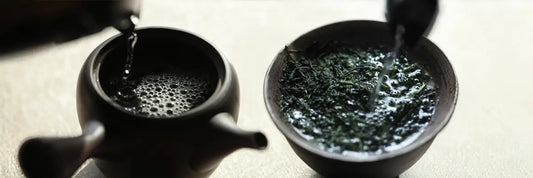The best gyokuro region can be a contentious debate, but in this article we’re going to try and get to the bottom of it.
We’ll start by discussing the different critera we used to evaluate the famous gyokuro region, then, we'll reveal you our personally favorite gyokuro region.
Without further ado, let’s get started! 🍃
What is the criteria for the best gyokuro region?
When we look for the best gyokuro region, we are looking for the region that has the reputation for producing the best gyokuro tea.
One more objective way to do this is by taking a look at the annual gyokuro competition in Japan, and seeing which teas tend to score the highest.
This is something we will take into consideration when making our list of the best gyokuro region.
Did you know there are 6 major tea growing regions in Japan? You can learn all about them in our article 👉 Where Does Japanese Tea Grow?
List of the best gyokuro region
Gyokuro tea is primarily produced in Japan. It is a high-quality Japanese green tea that is known for its unique cultivation and processing methods.
The regions in Japan that are famous for producing gyokuro tea include Yame, Shizuoka, Uji, and Kagoshima, as mentioned earlier.
Yame in Fukuoka has earned a prominent position as the premier gyokuro region, renowned for consistently producing high-scoring teas in competitions, despite its small size.
Shizuoka, the largest tea growing region, is not widely acknowledged as the top destination for gyokuro due to its climate that favors the Yabukita cultivar, which is better suited for matcha rather than gyokuro.
Uji, celebrated as the finest matcha region, holds great historical significance in Japanese green tea production and is a sought-after location for tourists interested in exploring the traditions of Japanese green tea.
Kagoshima, the second largest tea growing region, benefits from its fertile soil and mild subtropical climate.
These regions have favorable climates, soil conditions, and tea farming traditions that contribute to the production of exceptional gyokuro tea.
Climate is important, because tea plants, particularly the plants used to make gyokuro can be quite difficult to grow. If you want to learn more you can read our article 👉 All you need to know the Gyokuro Plant
#1 Yame
Yame is a town in Fukuoka that is without a doubt known as the best gyokuro region. If you were to ask anyone in the tea industry which place has the reputation for being the best gyokuro region, Yame would come up time and time again.
This is due to the fact that during the annual gyokuro competition, a majority of the highest scoring teas are all from Yame.
With the prolific notoriety of Yame, you would think that it is a large region, but it is actually very small compared to the others on this list.
Yame is a subregion within Fukuoka
Yame, in fact, is not even a region but a subregion within Fukuoka. Fukuoka is only responsible for 3% of the total tea fields in Japan, with Yame making up a fraction of that. Even though it is small, it has the almost unanimous reputation as the best gyokuro region, so there must be something special there!
#2 Shizuoka
Shizuoka is the biggest tea growing region by far, but it is certainly not known as the best gyokuro region. This actually has to do with the climate. Just like wine is broken down into varietals, tea is broken down into different cultivars. Some cultivars are smoother and sweeter than others, and these are more suitable to produce gyokuro tea. The problem is that the milder, more delicate cultivars tend to be more vulnerable to frost.
Yabukita cultivar
This is why in Japan's largest tea growing region, which is also one of its northernmost, the tougher Yabukita cultivar is the most common. The Yabukita cultivar is flavorful, but it tends to be a bit strong or bitter to produce premium matcha and gyokuro tea. That is why you will see smooth and round okumidori gyokuro, light and sweet saemidori gyokuro being produced in Southern Japan and not in the north.
#3 Uji
Uji may not be known as the best gyokuro region, but it is known as the best matcha region. Uji has a long history of green tea production in Japan. The original place where Japanese green tea way cultivated is not to far from Uji, located around Kozanji Temple in the Toganoo mountains outside of Kyoto.
Soon, tea production migrated south to Uji, which became the hotbed of tea cultivation and innovation for the next few hundred years. Gyokuro was actually first discovered in Uji, in the small town of Ogura.
Uji is even more famous for the production of matcha. If you want to learn more about the history of matcha in Uji, you should read this article here 👉 What is Uji Matcha and Why is it the Most Famous Tea?
Uji Compared to Yame
Although Uji does not have the strong reputation for being the best gyokuro region like Yame does, it is probably the most famous spots for international tourists coming to explore Japanese green tea. Here you can take part in a traditional tea ceremony, and visit historical sites like the world’s oldest teahouse.
Before you take part in a tea ceremony, you might want to brush up on your tea ceremony etiquette with our article 👉 Japanese tea ceremony guide
#4 Kagoshima
The final candidate for best gyokuro region is one we are a bit partial to and that is Kagoshima. Kagoshima is the second largest tea growing region in Japan, and it benefits greatly from rich fertile soil and mild subtropical climates. When we first visited the region of Kagoshima a few years ago, with met with the legendary farmer Mr. Sakamoto.
Best tea farmer from Kagoshima: Mr. Sakamoto
Mr. Sakamoto is a talented tea farmer in Shibushi that specializes in the production of Gyokuro tea. He has been working in the tea industry since he was a little boy, and when it was his time to take over the family business in 1985, he decided to turn the field completely organic.
Now, he and his brother produce gyokuro tea on this field, without the use of pesticides or chemicals. He has developed his own recipe for organic fertilizer, and he uses it to produce healthy, flavorful green tea without harming the natural ecosystem. If you’re interested in trying some of his gyokuro for yourself, we recommend starting with the Gyokuro Cha Musume, the most popular gyokuro tea.
In fact, Mr. Sakamoto is such a great farmer, he even has his own article! You can read all about it by following our guide 👉 Mr. Sakamoto Green Tea
Final thoughts on the Best Gyokuro Region in the World
The best gyokuro region is determined by the reputation for producing high-quality gyokuro tea. The annual gyokuro competition in Japan helps identify regions with the highest-scoring teas. In Japan, gyokuro tea is primarily produced in Yame, Shizuoka, Uji, and Kagoshima.
Yame in Fukuoka stands out as the best gyokuro region, known for consistently producing top-scoring teas in competitions. Despite being a small subregion, it has a strong reputation.
Shizuoka, the largest tea growing region, isn't recognized as the best for gyokuro due to the climate favoring the Yabukita cultivar, which is better for matcha than gyokuro.
Uji, known as the best matcha region, has a historical significance in Japanese green tea production and is a popular destination for tourists exploring Japanese green tea traditions.
Kagoshima, the second largest tea growing region, benefits from fertile soil and mild subtropical climates. The region is home to Mr. Sakamoto, a renowned organic gyokuro farmer, who produces healthy and flavorful teas using sustainable farming practices.




